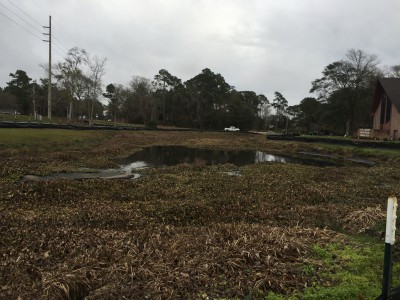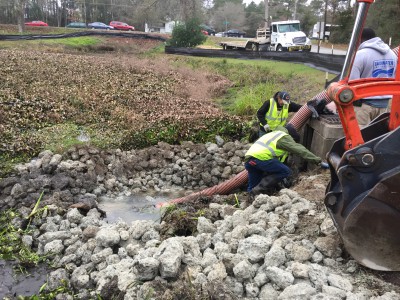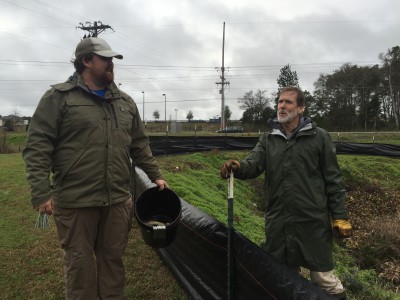Reprinted from Tideland News and updated.
CAPE CARTERET – Andy and Carson Wood of Habitat Environmental Services of Hampstead started living on turtle time Wednesday, as work began on the long-awaited project to transform two eyesore ponds here into an aesthetically pleasing storm-management system that should improve water quality in Deer Creek and Bogue Sound.
Supporter Spotlight
The father-and-son duo was on site at the Cape Carteret Baptist Church and Cape Carteret Presbyterian Church ponds – across N.C. 24 from the Lowe’s shopping center – as Backwater Environmental of Pittsboro, under contract to the N.C. Coastal Federation, began work that was expected to continue through the week.
The plan was to lower the water level in the pond, believed generally to be four to seven feet, to just a couple of feet, and to wait for wildlife, including the aforementioned turtles, to start emerging. Thursday and Friday, Backwater was installing fences, which will keep the wildlife within a perimeter near the ponds and out of the nearby traffic, and the Woods were putting in 50 traps – buckets, really – into which the turtles will stray.
Once they’re caught, the turtles will be transported to nearby, suitable habitat, approved by the N.C. Wildlife Resources Commission, probably within a mile or two.
“It’s not required,” Andy Wood said of the effort. “And it’s going to take time, because the water level is going to be lowered slowly, and turtles will come out slowly. But this is a great thing they (the federation and Backwater) are doing. It’s a special effort by everyone involved.”
In fact, Andy Wood said, an effort to capture and relocate wildlife during such a project is downright unusual.
Supporter Spotlight
“Most of the time, when people are doing this type of thing, they don’t even give it a second thought,” he said. “These kinds of ponds, stormwater retention ponds, get created, and over time, they become ‘naturalized,’ and when they are altered or filled in, they just do it. This is great.”
One doesn’t want to move the critters too far, Andy Wood said, in part because they prefer not to travel except by their own means, and in part because “they have their own sort of GPS and tend to get disoriented” if they’re moved too far.
As for “turtle time,” he said, it’s impossible to tell exactly when the amphibians will emerge. Since you can’t just sit there and wait indefinitely, all the time, you come and go, checking and re-checking. You don’t, he said, want them to stay trapped long.
Nor does he have any firm idea how many there might be. There could be a few dozen, or there could be a hundred or more.
What he does know is there’s surely an “alpha” turtle, probably a snapper of 10 pounds or more, plus all kinds of other turtles, including sliders and other species, ranging from half-dollar-sized hatchlings to 12-inch adults. The goal is to catch as many as possible, and to take them where they’ll be happy.
Wood is experienced in these things, having done even larger projects in Wilmington and elsewhere, and he says he knows some turtles won’t make it, and some “will end up in people’s homes, because once we get started, kids will be out here checking the buckets.”
But they will do the best they can.
There also will be eels, fish, countless frogs, many snakes and a maybe a few nutria, although Wood said the big critters are notoriously shy of humans.
“They might already be gone,” he said. “They see this truck (from Backwater Environmental) and they say, ‘uh-oh, time to move on.’”
All of the creatures will be moved, if possible.
There also are, or at least have been, otter in the ponds, but Wood suspects they will move on, too, and not be trapped for relocation. Otter, after all, are about as mobile as any critter, and there’s plenty of water habitat for them in nearby creeks. And when the water level sinks low enough, the otter will return from nearby and have a field day feeding on fish in the shallow pools.
The good thing about this, Wood said, is that there’s no real urgency. As long as the weather is relatively cool, the wildlife will be fine, and federation volunteers will help as critters continue to emerge.
Also, the really disruptive work won’t begin for some time; the current drainage won’t remove all the water from the pond, but the roughly four-day effort should lower the water level by several feet.

Once the drainage work is done, the federation’s coastal scientist Lexia Weaver said, actual construction of the new wetlands system should begin, likely by early February. That’s when the action should become noticeable, with heavy equipment on site to start moving dirt around. Below the water, for example, there are a couple of feet of “muck” that will have to be removed.
Contractors will by early spring be ready to take advantage of the growing season by planting wetlands vegetation to replace the overwhelming concentration of water hyacinths that have choked the ponds, limited their functionality and created the eyesore.
There will also be landscaping around the ponds, and Wood believes some wildlife – turtles, for example – will repopulate.
The federation project will connect the two ponds through an innovative underground system.
When complete, the system is expected to effectively and naturally treat stormwater that drains from the church properties, as well as from N.C. 24 and from shopping center properties across the street, protecting and improving the water quality in Deer Creek and ultimately Bogue Sound.
All of the work, which has been in planning for three years, was initially supposed to cost about $200,000, but it could now exceed $400,000 or as much as $500,000. The federation views it as a good deed for the town, and for the creek and the sound.
“The creek has been closed to shellfishing for a long time (because of stormwater runoff and the pollution it carries), and the hope is that someday shellfish harvest might be allowed again,” Weaver said. “There is no guarantee that will happen. But at the very least, we know that every bit of help we can provide for Bogue Sound is a good thing.”
The federation’s work with the town to obtain all necessary state permits took longer than expected.

All told, the federation expects to put in more than 18,000 plants, ranging from wetlands grasses to small trees suitable for the habitat, Weaver said. The organization is working with a top-notch expert, Wes Newell of Backwater and Lumber River Native Plants of Gibson, a nursery that has also worked with the federation on the successful and ongoing effort to return the sprawling North River Farms property in down east Carteret County to the wetlands role the land played before it was farmed for decades.
In addition, the federation has worked with engineer Kris Bass of Raleigh to design the system. Bass also worked on the North River Farms project, Weaver said, and worked at N.C. State University in the engineering department for a decade. He’s an expert in stormwater and ecosystems restoration, and he and the federation came up with an innovative system for the Cape Carteret project.
The stormwater will first enter the smaller, upper (farthest from Deer Creek) of the two basins on the Baptist property. This pond will be rebuilt to have sand and rock layers below the planted vegetation and will serve as a bio-retention area, filtering as much of the pollutants as possible from the collected stormwater.
The water that remains will flow to the larger basin on the Presbyterian property. And the real innovation, Weaver said earlier this year, is that this part of the system will be a tidal salt marsh.
“The idea,” Weaver said, “is not to keep them as ponds; they should be dry most of the time, except when it rains a whole lot.”
Then the federation closed on the sale of an easement at its massive North River Farms wetlands project, and earned $3 million. Federation executive director Todd Miller thought cleaning up the ponds would be a neighborly – and environmentally significant – thing to do.










